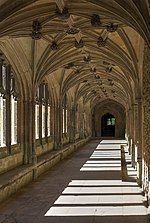Lacock Abbey in the village of Lacock, Wiltshire, England, was founded in the early 13th century by Ela, Countess of Salisbury, as a nunnery of the Augustinian order. The abbey remained a nunnery until the suppression of Roman Catholic institutions in England in the 16th century; it was then sold to Sir William Sharington who converted the convent into a residence where he and his family lived. It was fortified and remained loyal to the crown during the English Civil War, but surrendered to the Parliamentary forces once Devizes had fallen in 1645.
The house was built over the old cloisters and its main rooms are on the first floor. It is a stone house with stone slated roofs, twisted chimney stacks and mullioned windows. Throughout the life of the building, many architectural alterations, additions, and renovations have occurred so that the house is a mish-mash of different periods and styles. The Tudor stable courtyard to the north of the house has retained many of its original features including the brewhouse and bakehouse.
The house later passed into the hands of the Talbot family, and during the 19th century was the residence of William Henry Fox Talbot. In 1835 he made what may be the earliest surviving photographic camera negative, an image of one of the windows.
In 1944 artist Matilda Theresa Talbot gave the house and the surrounding village of Lacock to the National Trust. The abbey houses the Fox Talbot Museum, devoted to the pioneering work of William Talbot in the field of photography. The Trust markets the abbey and village together as "Lacock Abbey, Fox Talbot Museum & Village". The abbey is a Grade I listed building, having been so designated on 20 December 1960.








